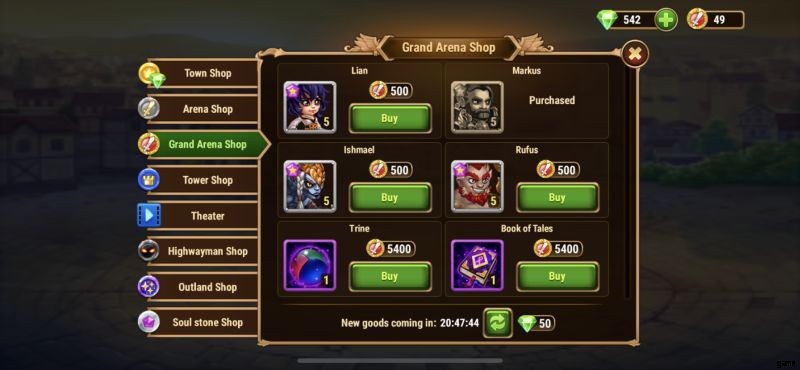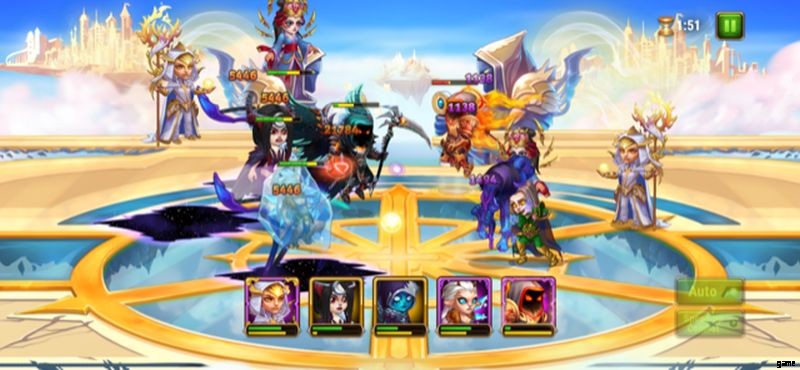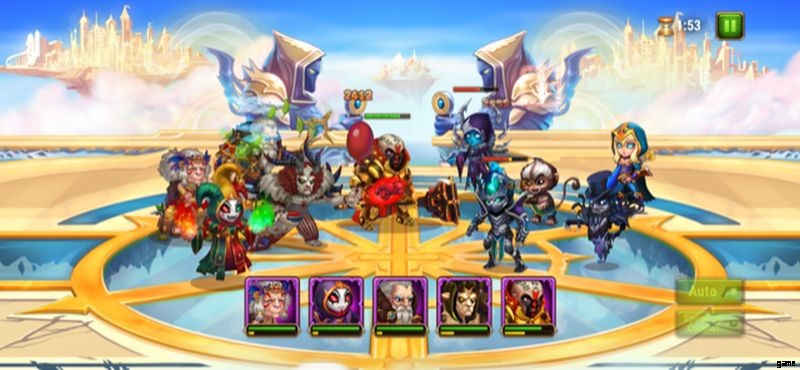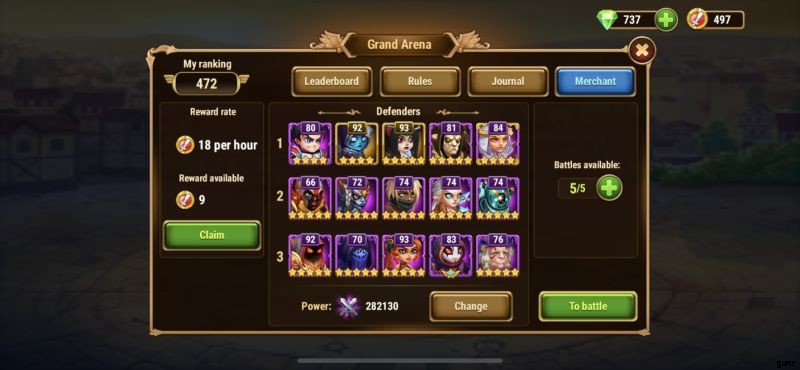Bis jetzt können wir noch immer nicht die Finger von Hero Wars von Nexters lassen, dem Action-Adventure-Rollenspiel derselben Firma hinter Island Experiment und anderen Titeln. Mit seiner leicht zu erlernenden Spielmechanik, vielen Funktionen und Spielmodi und der guten Balance zwischen PvE- und PvP-Modi ist es keine Überraschung, warum dieses Spiel auch dann noch so beliebt ist, wenn es schon eine ganze Weile im App Store und Play Store erhältlich ist. Darüber hinaus erhält das Spiel regelmäßig Updates, einschließlich des Halloween-Updates, das die Anzahl der verfügbaren Helden auf 47 erhöht hat – wer weiß, vielleicht haben wir vor Jahresende sogar vier Dutzend. Du kannst auch an besonderen Events teilnehmen, die dir helfen könnten, mehr Seelensteine zu verdienen und mehr Helden freizuschalten! (Neben anderen Extras, die Sie bei diesen Events gewinnen können.)
Unter all den Modi im Spiel ist die Große Arena ziemlich interessant – verglichen mit dem Turm und der regulären Arena spielen nicht allzu viele Leute sie, aber wie Sie bald genug herausfinden werden, gibt es einen Grund dafür und einen ziemlich verständlich. Aber das bedeutet nicht, dass Sie diesen Spielmodus übersehen sollten, denn Sie werden diese Ranglisten verbessern wollen, wenn Sie mehr Grand Arena-Münzen verdienen und einige der Helden des Spiels freischalten möchten, indem Sie genügend Seelensteine kaufen. Und das wird einige Kenntnisse erfordern, um die bestmöglichen Teams für Ihre Einheiten in der Großen Arena zusammenzustellen. Lies weiter, während wir dich durch alles führen, was du zum Aufbau des perfekten Grand-Arena-Teams in Hero Wars lernen musst.
1. Die Große Arena – Ein Überblick
Die Grand Arena ist der letzte Spielmodus, den jeder Spieler in Hero Wars freischalten kann, da er verfügbar wird, sobald Sie Teamlevel 50 erreicht haben. In Bezug auf die Mechanik ist er der regulären Arena ziemlich ähnlich, da er 5-gegen-5-Kämpfe bietet andere Spieler, bei denen Sie nur die Helden für den Kampf auswählen müssen und alles andere – also so ziemlich die Aktivierung der Spezialfähigkeiten – von der KI erledigt wird. Außerdem sind maximal fünf Schlachten pro Tag erlaubt, es sei denn, Sie sind bereit, einige Smaragde auszugeben, um einige zusätzliche Schlachten zu erhalten.
Hier enden jedoch die Hauptähnlichkeiten, da die Große Arena allein ihrem Namen nach mehr Action bietet – hier treten Sie in Best-of-Three-Kämpfen gegen rivalisierende Spieler an und wählen insgesamt 15 Helden in drei Gruppen aus von fünf. Dies gilt wiederum sowohl für Ihre Offensiveinheit, die Sie verwenden, wenn Sie tatsächlich an den Kämpfen teilnehmen und Zeuge der Kämpfe sind, nachdem Sie einen Gegner herausgefordert haben, als auch für Ihre Defensiveinheit, die es mit der gegnerischen Einheit aufnimmt, wenn Sie herausgefordert werden .

Ein weiterer wesentlicher Unterschied zwischen der regulären Arena und der Großen Arena ist die Art und Weise, wie Währung verdient wird. Während Sie bei Standard-Arenakämpfen 20 Arenamünzen pro Sieg verdienen, werden Große Arenamünzen passiv pro Stunde und basierend auf Ihrer Platzierung auf der globalen Bestenliste verdient – das heißt, wenn Sie mit Ihrer Platzierung zufrieden sind, können Sie tagelang darauf verzichten eine große Arenaschlacht, da Sie nicht kämpfen müssen, um Ihre Arenamünzensummen zu erhöhen.
Wenn Sie beispielsweise zwischen 501 und 700 rangieren, erhalten Sie 14 Grand Arena Coins pro Stunde, während Sie bei einem Rang zwischen 701 und 1000 10 pro Stunde erhalten. Schaffe es bis an die Spitze der Rangliste und verdiene 70 Grand-Arena-Münzen pro Stunde! Große Arena-Münzen können verwendet werden, um verschiedene Gegenstände im gleichnamigen Shop sowie Seelensteine für die folgenden Helden zu kaufen – Lian, Marcus, Rufus und Ishmael.
Verwandt: Hero Wars (Nexters) Farming Guide:So erhalten Sie mehr Gold, Smaragde, Seelensteine und seltene Ausrüstung
Zusätzlich zu den oben genannten Ähnlichkeiten kannst du deinen Rang in der Großen Arena verbessern, indem du jemanden mit einem höheren Rang besiegst und seinen Platz einnimmst, genau wie in der Standard-Arena. Es gibt auch eine Abklingzeit von einer Minute zwischen den Kämpfen, aber da Große Arena-Kämpfe länger dauern, weil sie einem Best-of-Three-Format folgen, müssen Sie wahrscheinlich nicht warten, bevor Sie einen anderen herausfordern können Gegner. Ebenso spielt Ihre Platzierung in der Großen Arena-Bestenliste eine Rolle bei der Qualität und Quantität Ihrer täglichen Arena-Belohnungen, ähnlich wie Ihre reguläre Arena-Rangliste.
Apropos Rangliste:Wir sollten auch erwähnen, dass höherrangige Spieler in der Großen Arena eine Art „Fog of War“-Vorteil haben werden. Bei Spielern zwischen 21 und 100 ist ein Team vor ihrem Gegner verborgen, bei Spielern zwischen 2 und 20 sind zwei Teams verborgen. Und wenn Sie der bestplatzierte Spieler insgesamt sind, werden ALLE drei Ihrer Teams ausgeblendet, sodass Ihr Gegner alles dem Zufall überlassen kann!
2. Stelle sicher, dass du mindestens 15 3- bis 4-Sterne-Helden oder besser hast, und halte sie auf einem höheren Level
Während es eine gültige Denkschule ist, sich mehr auf Qualität als auf Quantität zu konzentrieren, wenn es um die Helden geht, die Sie in Hero Wars beschwören, müssen Sie mindestens ein Drittel der verfügbaren Helden mit einer ausreichend hohen Sternebewertung und einem ausreichenden Level haben um in der Grand Arena konkurrenzfähig zu sein. Das bedeutet, dass du mindestens 15 dieser Helden mit drei oder vier Sternen und einem Level benötigst, das deinem Rang auf der Bestenliste entspricht.
Wenn Sie beispielsweise zwischen 401 und 500 eingestuft sind, möchten Sie wahrscheinlich mindestens 15 mit vier Sternen und auf Stufe 65 oder höher haben, wobei mindestens fünf dieser Helden auf Stufe 80-90 und höher sein sollten. An diesem Punkt solltest du außerdem mindestens fünf Helden mit fünf Sternen haben, und du solltest auch sicherstellen, dass du alle drei deiner Teams richtig ausbalancierst, wie wir weiter unten besprechen werden!
Anders ausgedrückt, Sie müssen eine ähnliche Gesamtstärke wie die meisten anderen Spieler haben, gegen die Sie antreten werden – Sie können nicht erwarten, Ihren 450-Rang beizubehalten, wenn Sie eine kombinierte Stärke von 225.000 oder haben weniger! (Rechnen Sie nach, das sind 15 Helden mit einer durchschnittlichen Stärke von 15.000.)
3. Halten Sie sowohl Ihre offensiven als auch Ihre defensiven Einheiten im Gleichgewicht
Egal, ob Sie Heldenteams auswählen, die als Ihre Verteidiger dienen, oder als Ihre Offensivteams, um einen Gegner herauszufordern, Ausgewogenheit ist wichtig. And this is something you may want to prepare for even before you reach level 50 and unlock the Grand Arena. It can be hard, after all, to play catch-up and spend precious resources on getting certain Heroes up to speed just because you had so much success early on with unbalanced teams of five in the Campaign, Arena, or in other modes.

Basically, you don’t want to spend all your coins and Emeralds and other resources on offensive-oriented Heroes – you shouldn’t neglect the Tanks that absorb damage up front even if they don’t offer much on the offensive end, the Healers that keep your top damage-dealers in the battle, and the various Support heroes who do the little things like cursing, stunning, or slowing down enemies. Maintain a balanced lineup for all your three teams, on top of what we advised you above, and you should be in good shape.
Each of the three teams ideally needs to have one Tank to soak up damage, two or three Marksmen, Mages, Warriors, or other characters with high Attack stats, and one or two supporting Heroes, usually one Healer and another who has a Control or Support role.
4. Which Heroes Should You Prioritize For The Grand Arena?
TANKS – Definitely, Astaroth and Galahad should be on top of your priority list in the Tank category. Not only do they get unlocked very early on in the game; they’re also very useful even in the later stages, with Astaroth serving a dual role on Support by protecting or resurrecting allies (including himself) and Galahad capable of doing a fair amount of damage for a Tank. For your third tank, Ziri is a good choice if you have her unlocked, thanks to her ability to burrow once her Health drops below 35 percent. Alternately, we would also recommend Luther , as it helps to have someone who could jump into the enemy’s backline and do damage to their Support Heroes – if leveled and starred up properly, he’s pretty useful against enemy teams that have Thea or Celeste in the backline!
DAMAGE-DEALERS – Regardless whether they’re Marksmen, Warriors, Mages, or whatnot, all Heroes capable of doing a great deal of damage against an opposing team are covered under this category. Let’s take a look at some of the better ones.
Ginger is a popular choice for many a Hero Wars player, and with good reason – her primary skill, Lead Storm, is a rapid-fire blast of bullets that hits all enemy Heroes, and she’s got some pretty good secondary and passive skills as well, while also boasting good durability for a non-Tank. Faceless may be a bit of a gamble, especially in Arena/Grand Arena where the battles are automatic, but the fact that he copies the primary skill of the last ally or enemy who used one makes him very effective if utilized properly. Cornelius can do a lot of damage with his primary skill, Heavy Wisdom, a monolith which hits the enemy with the highest Intelligence – this can be deadly against rival Healers.

Aside from those three, we also recommend Keira , provided you complement her with a Healer – she is one of the squishier characters in the game, though her lack of durability is mostly offset by her high-damage skills. Astrid and Lucas is technically a backline (pair of) character(s), but it’s hard to argue with how effective they are when the former unleashes the latter with her primary skill – that cat can sure do a number on enemy Tanks. Elmir , meanwhile, is the opposite – a front-line Hero who jumps back with his primary skill, but mainly frustrates enemies by cloning himself and creating up to four decoys that absorb AND deal out damage. (They cannot, however, regenerate health!)
Lastly, we would suggest the brother-sister duo of Lars and Krista , who work best if they’re on the same team, but while the former is more of a Support Hero, the latter is very effective if used as a standalone damage-dealer (particularly with Icy Vengeance as an area-of-effect skill) while also being comparatively sturdy. Ishmael is a good choice for those who want to gamble on critical hits, as that’s what his demonic form (via Awakening) does best. You can also prioritize Orion if you’re looking to target enemies with the highest health and take out the usually Support-dominated enemy backlines.
SUPPORT – All Heroes categorized as Healer, Support, or Control fall under this broader group, and at this point, we’ve gotten some of the best results in various modes with Celeste as our go-to Healer. When switching to Light Form via Two Fates, she can offer a quick pick-me-up to the ally with the lowest health, and when switching to Dark Form, she does the opposite by creating a Cursed Flame around the enemy unit, preventing any surrounding enemies from being healed for the next five seconds. But that doesn’t mean you should neglect Thea , who is the first Healer which Hero Wars players can unlock – her skills may not seem as impressive as Celeste’s, but her basic Solar Sanctuary skill, as stated, heals ALL allies.
Verwandt: Hero Wars (Nexters) Character Skills Guide:Ein vollständiger Leitfaden für alle 45 Helden
Jorgen has quietly become a favorite of ours, as mentioned in a previous guide, as his Control skills mainly have the effect of preventing enemies from gaining energy, thus preventing them from using their skills. He’s also quite durable, but not as much as Martha , who contributes next to nothing offensively, but can also help heal allies with the lowest health while also serving as an effective backline Tank.
Dorian’s main benefit comes through his main skill, Fountain of Blood, which helps allies recover health when they attack enemies he curses with the Mark of Blood, as well as his passive Initiation skill, which increases an ally’s Vampirism – if you notice an enemy staying much longer in battle than they should, that’s oftentimes a result of Initiation, which works even if Dorian’s already been killed. As for Nebula , we’ve yet to use her extensively in the different game modes, but she seems to do well for opposing human and AI-controlled teams alike as an all-around Support Hero – depending on the skill, she can deal AoE damage and sap energy, heal low-health allies, or target low-health enemies.
5. Assembling Your Defensive Unit – Don’t Spread The Talent Across
When forming your three defensive teams for the Grand Arena, the general rule here is to avoid setting things up in such a way that all three teams have similar total power ratings. Remember that these are best-of-three battles; you can take one loss and still defeat your opponent if you win the two other matchups. Spreading your talent across the board, while still effective against a much weaker opponent (which you’ll rarely see, thanks to Hero Wars’ generally fair matchmaking system), won’t do you any favors against most opponents whose team power is fairly close to yours. That’s because in general, players’ groups of Defenders usually consist of two teams that are considerably stronger than the third.

It doesn’t matter if you field the weakest links among your Defenders as your first, second, or third team. You can set things up in a way that you expect to lose the first matchup and win the next two, win the first, lose the second, and win the third, or win the first two and have the third team as a backup in case you and your opponent split matchups one and two. Any of those three strategies are better than spreading the wealth, though as we mentioned above, the principle of having a balanced party of Heroes applies as always.
6. Choosing Your Offensive Unit – Always Look At Your Opponent’s Teams
The same principle as above applies when you’re choosing your three teams of five and challenging an opponent – most of the time, you wouldn’t want to field three teams of similar total power, and most of the time, you’re better off deliberately losing one matchup and trying to win the other two. But choosing offensive teams comes with an additional wrinkle – unless you’ve got a really high ranking, meaning the top 100, you can view everyone on your opponent’s teams. You can see each Hero’s name, level, and each team’s total power, and you can use this information as a guide when choosing each team – or choosing specific Heroes for a certain team. So what’s next after you choose an opponent?
Also keep in mind that you can always refresh the list of possible opponents if none of the three appeal to you – maybe they’re too tough to defeat, maybe their ranking isn’t worth chasing, or maybe you want a challenge and don’t want the easy pickings. But once you’ve made your choice, you can then view the relevant information we mentioned above, and take it from there – for example, if you see your opponent’s first team is particularly weak, you can choose a team of five that is barely good enough to win, saving your better Heroes for the second or third team. Conversely, if your opponent’s first team is unbelievably strong, you can sacrifice your weakest Heroes, especially if you know you’ve got a chance of winning the next two matchups.
Verwandt: Hero Wars (Nexters) Advanced Guide:Tips, Strategies &Tactics to Win Arena Battles and Dominate All Game Modes
Choosing Heroes on offense also gives you many chances to fine-tune things by choosing specific Heroes, including the examples we discussed above, where you can select Luther as your tank in order to easily eliminate an enemy backline Healer like Thea or Celeste, or Cornelius if you’re trying to target those same Healers or other high-Intelligence characters without jumping into enemy territory. If the opposing team’s tank is Chabba, then perhaps it’s time to field Astrid and Lucas so that the former can unleash the latter on this particularly high-Health character. Or maybe the opposing team is loaded with low-offense Support and/or Tanks – you could select four high-offense Heroes and one Healer for better chances of winning.
At the end of the day, it will all depend on the Heroes you’ve summoned, and it may also depend on your personal preference. But the bottom line is that offensive strategy in the Grand Arena tends to be more intricate and requires more decisions than defensive strategy – still, many of these decisions will soon become second nature if you keep taking part in Grand Arena battles!
